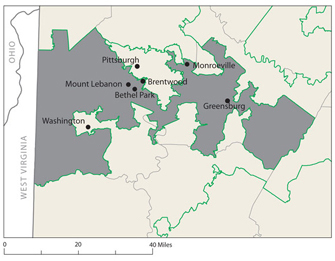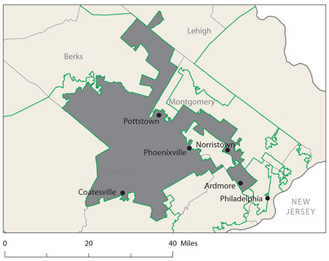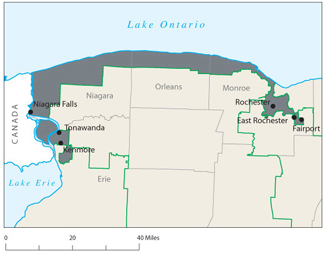|
|
|
The Redistricting Game is a web site, designed by the University of Southern
California Game Innovation Lab, designed to educate and empower citizens around
the issue of legislative redistricting. Currently, legislatures themselves are
authorized to redraw district boundaries, and this leads to abuses -- districts
are drawn to protect incumbents and parties in power. The Redistricting Game
allows citizens to see how the redistricting system works, and how it could be
abused. It also provides information on reform efforts, including a playable
version of the Tanner Reform bill, which would make the redistricting process
more amenable to public needs.
| |

Legislative redistricting 2010
Americans for Democratic Action Forum
-- John Oliver Mason
The Philadelphia chapter of Americans for Democratic Action (ADA) held a town
hall forum on legislative redistricting at the sanctuary of First Unitarian
Church, on Chestnut Street in Center City.
DeWitt Brown, Chair of the Philadelphia ADA, welcomed the audience and introduced
the panel -- Chris Satullo, News Director for WHYY; State Representatives
Babette Josephs and Josh Shapiro; and City Councilmember Maria Quinones Sanchez.
“In 2010,” said Brown, “the US will conduct its Census. The Census will (begin
the process to) draw up everything from US congressional districts to
Philadelphia’s councilmanic districts. To prevent the people who draw up the
lines from disenfranchising another generation of voters, Philly ADA has
convened this forum this evening to help raise the profile of this issue in
preparation for the next round of” rewriting district boundaries. Brown also
hope to address how voters could influence the redistricting process.
Satullo spoke first, discussing the problems with how the boundaries of
congressional and legislative districts have been drawn. “Gerrymandering,” he
said, “is the fine dark political art of drawing the lines of political
districts so as to benefit one or two constituencies. One constituency is the
incumbents, to try to make their seats as safe as possible. The other
constituency is the party in power, which happens to be drawing the lines to
maximalize their majorities in the legislature. Neither of those constituencies
involves you, as voters and citizens.”

|
|
Pennsylvania's 18th district - Tim Murphy, R.
|
|
Satullo said that gerrymandering could undermine democracy in many ways: “It
protects incumbents,” he said. “Our democracy doesn’t work well when incumbents
know they can’t lose. When they can’t lose, they don’t need to compromise, and
they don’t have to listen to different voices.” In drawing up legislative
district boundaries, added Satullo, poorer municipalities and counties could be
represented by several districts in the same county or city, so that legislators
could ignore their problems without having to worry about being voted out of
office. Minority areas, he added, could also be disenfranchised this way.
The next speaker was
Babette Josephs, who represents the 182nd Legislative District (which covers
parts of Center City Philadelphia), and who is the Chairwoman of the State
House’s Committee on Government, which oversees the redistricting process. “This
is a great lot of people,” she told the audience, “to hear a very dry but very
important topic.
“I know that people who have been following this story,” added Josephs, “feel
incredibly frustrated that we don’t seem to be able to make any progress to
having a more transparent (political) process, which has to lead to a better
result. And I have to tell you, I share your frustration. Harrisburg is a hugely
frustrating place, when it’s to the point of madness almost when you can’t move
things forward, that are so obviously the right thing to do.”

|
|
Pennsylvania's 6th district - Jim Gerlach, R.
|
|
Josephs cited her own experience in Harrisburg on reproductive rights for women.
“I never expected this issue to be resolved in a day, or a week,” she added,
“but I didn’t think that two decades later…when we had a vision of women’s
health care that would include allowing sexual assault victims the opportunity
to use emergency contraception that the ugly head of abortion, and the people
who support the anti-abortion point of view, would be able to prevail last
session and basically kill the bill which would have allowed rape victims, no
matter what hospital they showed up at, to be able to use emergency
contraception, if that’s what they chose.” But, she said, “we’re going to work
on this again, because this is an important issue.”
Another issue Josephs has had to struggle with in the legislature is workplace
discrimination: “I could not get out of committee, in the last session” she
said, “a simple bill which would allow the Pennsylvania Human Relations
Commission to investigate and vindicate people’s rights if they were
discriminated against based on their sexual orientation or gender identity or
expression.
“It’s just a simple, fair thing,” Josephs added. “People say, ‘Why can’t you get
that to happen?’ We can’t do it because the vision that you and I and everybody
here shares about what our society should look like is not shared by the Right
Wing. The Right Wing is present, they’re in Harrisburg, and they’re working
hard, and they do not people to have equal rights, they don’t want women to have
decent health care. It’s very frustrating and very difficult to keep our vision
moving forward.”
Nevertheless, said Josephs, “Representative Shapiro and I, and all the rest of
the people who share our common values, are going to go back” to Harrisburg, to
meet with other supporters of ending job discrimination against gay and lesbian
people, and to continue to push for such legislation.

|
|
New York's 28th district - Louise M. Slaughter, D.
|
|
The next speaker was Josh Shapiro, who represents the 153rd Legislative District,
which covers parts of Montgomery County, and is Deputy Speaker of the
Pennsylvania House and Co-Chair of the Speaker’s Commission on Legislative
Reform. “I’m very excited,” he said, “to be here and to talk about an issue I’m
very passionate about.” Of the importance of public forums to discuss legislative redistricting, Shapiro said, “I find that…if we improve upon our
redistricting process, how we draw our districts, we will yield from that better
constituent services, because people will find it easier if they know who their
legislator is, who their congressman is, it’ll be easier for them to get to the
office, to show up for a town hall meeting, or it’ll be easier for that
congressperson or that legislator to be able to meet the needs of their
constituents, in more compact or contiguous districts.”
Another advantage reforming the redistricting process, said Shapiro, is “It will
better legislative results if we draw our districts in a more fair and less
partisan way.” Most of the legislative districts in Pennsylvania, he said, are
drawn with majorities of one party or another. “If you’re a legislator in one of
those districts,” he added, “and you’re concerned with meeting the needs of your
constituents, you tend to be very one-dimensional, in a partisan approach to a
particular issue.” The opposing party in the district, he said, could be safely
ignored.
Shapiro added it was also a values question;
redistricting reform, he said, would be “one of the key ways to make our
government work better” for citizens; “If we elect people, in a fair and less
partisan manner, we will have better government and less partisan government.
That is ultimately our value and our objective.”
City Councilwoman Maria Quinones-Sanchez, who represents the Seventh Councilmanic
District of Philadelphia, was the final speaker. Speaking of the fact that her
district was named the “most gerrymandered district” in the country, and of the
upcoming Census, she said, “this is where advocacy groups like ADA need to be at
the forefront of making sure that we have an accurate count in the Census.”

|
|
Maryland's 2nd district - Rep. Dutch Ruppersberger, D.
|
|
Since 1950, said Quinones-Sanchez, Philadelphia has been losing population; “We
reached our peak,” she said, “in 1950, when we had about 2.1 million people, and
we’re now down to close to 1.5 million, which was the same population in 1910.”
Also, added Quinones-Sanchez, “The Latino population has grown, just in the last
Census alone, forty-five percent. So when we talk about disenfranchising
minority communities and bilingual, multicultural, and multilingual communities,
this should be a great concern to us. This growth in the new immigrant
(communities) that have led to us maintaining congressional districts.”
Meanwhile, at the joint meeting of the American Mathematical Society, the Mathematical Association of America, the Association of Symbolic Logic, the Association for Women in Mathematics, the National Association of Mathematicians and the Society for Industrial and Applied Mathematics held this year in Washington DC, Prof. Daniel H. Ullman of George Washington University organized a special session on the value and use of political redistricting algorithms. Other speakers Richard Pildes of New York University’s Law School, Micah Altman of Harvard University, of George Washington University organized a special
session on the value and use of political redistricting algorithms. Other
speakers
Richard Pildes of New York University’s Law School,
Micah
Altman of Harvard University,
Michael P.
McDonald of George Mason University,
Nathaniel
Alfred Persily of Columbia University,
James M.
Snyder of the Massachusetts Institute of Technology, and
Christopher
P. Chambers and Alan D. Miller of the California Institute of Technology.
In his coverage of the conference for d district' is," Wilson concluded. "Writing a formula for drawing districts requires us to define how funny-looking is too funny looking."
Ullman described one school of thought on the question. "The idea is that circles are the best shape for districts," he said. "Unfortunately, they don't tessellate well."
The January session was unique in that it brought together a large, diverse group of mathematicians to hear presentations by law professors, redistricting litigators, leading political scientists, and mathematicians who worked in a variety of fields including optimization theory, game theory, and statistics. It was one of the first times that mathematicians and redistricting practitioners had talked.
Scientists & Engineers for America would like to continue this project and set a goal of positively influence redistricting by the time the 2010 census data becomes available in early 2011. The first targets of opportunity are the commissions and other bodies that have been established for independent redistricting in California and other states. Their next step is to publish expanded proceedings with support from the Russell Sage Foundation to serve as a base for further efforts over the next four to six months while they seek funding for the next stage, which could involve perfecting the mathematics, designing redistricting tools, and coming up with lay explanations for what they are doing.
Did you enjoy this article?
If so,
- share it with your friends
so they do not miss out on this article,
- subscribe
(free), so you do not miss out on the next issue,
-
 donate
(not quite free but greatly appreciated) to enable us to continue
providing this free service. donate
(not quite free but greatly appreciated) to enable us to continue
providing this free service.
If not,
|